The best way to understand depression is to track your symptoms and triggering events each day. The question is: How to do it. To start with, you might use a written diary, or just a list on note paper. But the more symptoms and triggering events you follow and the longer you keep up with it, the harder it is to reorganize the information to get a good picture of patterns and connections.
That’s why I’m focusing on software in this post, especially online applications, or web apps, that you can access with a browser from anywhere.
A good online mood tracker preserves all the data you enter over time, presents it visually in a chart or graph and allows you to print and/or download the results. You get a useful report instantly and can look at it in different views. Many web apps have mobile versions that you can use on a smart phone.
But they’re not all created equal, and after testing a number of online mood trackers, I’ve picked out four to review here.
Any software that’s new to you, whether online or on your desktop, can have a discouraging learning curve. The web apps, however, are designed to be simple and readily useful to visitors with little computer experience. After all, they aren’t written for geeks but for people with an urgent need to learn more about their illness.
These four apps are quite different, so I won’t compare them to each other. They’re all good at what they do, and you’ll need to decide which one best fits your goals and style of working.
Optimism Web App
Optimism, available in desktop and mobile as well as online versions, enables you to track a large number of symptoms and many other dimensions of your illness and treatment. James Bishop, its author, recently made this a free application in all its forms. It was well worth the price at the time I bought it. Now that it’s free, there’s no barrier to trying it out.
The opening screen is the first of five, as indicated by the five tabs across the top, shown in the two images I’ve included.
That first screen is for recording several aspects of your condition. Though it might look a bit overwhelming at first glance, the use of sliding scales and check boxes makes entering information fast and efficient. The top section covers the basics of mood, coping, sleep, exercise and medication use. After that are sections for stay-well strategies, triggers and symptoms.
You can change any of these or add new items. You decide how many are relevant for your tracking. The flexibility of the application means that you can adapt it for any other mood or physical disorder you may be dealing with. Here’s a screen shot of that form.
Second is a chart for visualizing progress for a time period of your choosing. This summarizes the same data categories you’ve been recording. The third tab gives you a text version of the information that can be downloaded as well as emailed to a doctor or therapist.
A fourth tab lets you isolate and make notes about individual items you’re tracking. The last tab brings up a screen for planning wellness strategies and treatments you want to follow.
Tracking this much information fits my needs perfectly, but it may well be overkill if you’re just starting to follow your symptoms. The next three web apps are much simpler, as well as being free. All you have to do is register at each site to get access to the mood tracker, and you can do that anonymously.
Bear in mind that there are a great many more mood trackers online. Several of the big health sites have them, but most prefer to emphasize symptom screening, rather than tracking, to help you figure out if you have a depressive disorder. I’ve chosen just three of the mood trackers that I find helpful and easy to use, but you may find others that fit your needs better. If you do, please let us know in the comments.
MedHelp.com
MedHelp offers a good set of tracking tools with multiple views of your results. The starting mood entry chart enables you to track seven mood levels throughout the day, every hour if you want to. For whatever frequency you use, you can indicate levels of as many as 30 different symptoms. Another tracking section lets you record whether or not you’ve followed treatment each day, and a fourth provides space for five conditions that might contribute to mood, such as family or work issues.
The visualized result consists of five sections stacked on top of one another. (For space reasons, the image shows only part of the full report.) There is a vertical bar chart for each day’s mood level, a graph showing the average mood over time, a chart showing the levels of as many as 30 symptoms, a section for treatment, and a final one for triggering conditions.
Another thing you might consider about this web app is that MedHelp also provides trackers for many other health problems – like chronic pain. You may have an illness concurrently with depression, and you may want to follow that as well.
I like MedHelp’s detailing of symptoms and the variety of ways for visualizing progress. As is often true on big health sites, navigation and instructions for using the tracker could be clearer, but on the whole this can be an effective system for monitoring your illness.
PsychCentral
PsychCentral is one of the oldest and most respected mental health sites and has amassed a wealth of information since the 90s. Its mood tracker is far simpler than the one at MedHelp, but simplicity can work well in capturing the essentials. The tracker helps you put together a basic portrait of the trend of your moods. You need to register on the site to use it, then, once logged in, you find the mood tracker under Quizzes in the menu bar.
You enter data by using a sliding scale to describe your level of agreement or disagreement with 10 statements about how you’re feeling. There 2 more asking you to fill in blanks about the quality and amount of sleep. Here’s the list of all 12 – but without the lines for your responses.
- I feel sad, blue or unhappy.
- I feel full of energy, hard to slow down, or have been more active than usual.
- I feel my future is hopeless, or that I’m worthless and am a failure.
- I’d describe my sleeping recently as:
- My attention keeps jumping from one idea to another, or I have so many plans and new ideas that it is hard for me to work.
- I feel irritable or restless.
- I feel nervous, nauseous, my heart pounding, dizzy, or have had shortness of breath.
- I have lost interest in things that used to be important to me.
- I have difficulty relaxing or sleeping.
- I have had periods of tearfulness and crying and other times when I laugh and joke excessively, or my self-confidence ranges from great self-doubt to equally great overconfidence.
- I have periods of mental dullness and other periods of very creative thinking, or there have been great variations in the quantity or quality of my work.
- Average hours of sleep I’ve had per night over the past week:
There is also a space for notes where you can add anything else you’d like, such as triggering events or treatments used that day.
This information yields a numerical score for depression, anxiety, mania and sleep, with an indication of which ones might be cause for concern. A chart is also provided which organizes the information on a slightly different scale, with columns showing whether you’re above or below a norm. There is also a graph that shows the trends of mood and sleep over the period you have tracked thus far and a section showing all your saved data. The charts can be printed, sent by email or downloaded in PDF format.
The charts and summaries are good, but the navigation is a problem. You have to go to three different locations to find all three versions of your data, and I missed one of them the first time I used the site. If you’re new to PsychCentral, this could be quite frustrating.
HealthyPlace.com
HealthyPlace is another big website covering many health conditions and including numerous community features. Once registered, you can find the tracker under Tools in the menu bar under the header on each page. Once at the tracker, you’ll find a clear setup that lets you record basic data quickly. You use dropdown menus to answer the key questions. Here’s the full list of measures in the questionnaire.
- Select your Mood – You indicate your basic mood (elevated/manic, normal or depressed). Then you can choose the level of that mood.
- Your Anxiety – You can choose a level for anxiety and then one for irritability.
- Your Hours Slept – How many hours did you sleep in the last 24 hours?
- Your Weight – Enter your weight in pounds.
- Your Medication – You can add multiple medications and doses.
- Your Daily Notes – You can write a brief diary entry on triggering events, and as you continue using the form, you can look for patterns.
You can print out a daily chart and a graph covering a date range you select. The program also generates a 30 day report. HealthyPlace has a prominent disclaimer and caution about using the tracker without consulting a mental health provider. To make it easier to relay information to your doctor, they include an optional alert form you can use to send a direct email, fax or SMS message.
Although the information tracked is limited, the ease of use in filling out the form and seeing immediate results would probably help you use the tracker every day. That’s a big advantage since the charts aren’t very useful if you don’t add the data consistently over a long period of time.
Using web apps is only one way to track depression, but after a lot of experiments I’ve settled on this solution. Whatever level of detail you want to follow, the most important thing is to track consistently – and to be honest with yourself with what you put down.
Please use the comments to let us know what method you use and what you’ve learned from the practice.
Image by Norman B. Leventhal Map Center at Flickr

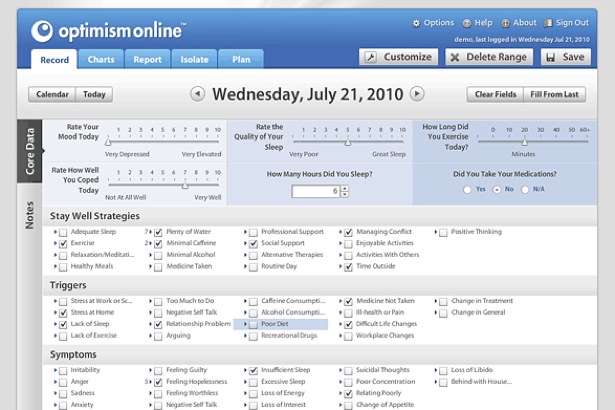
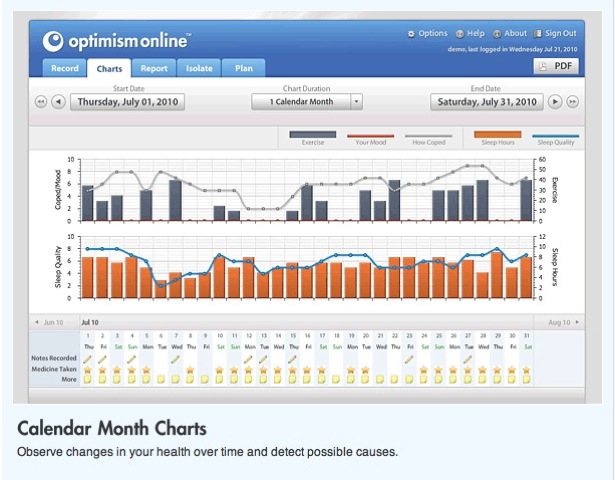
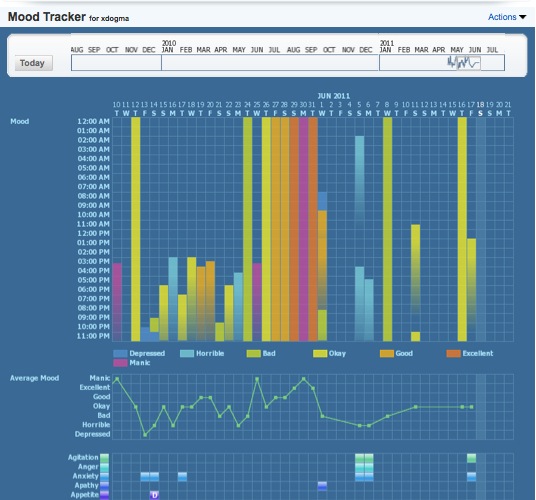
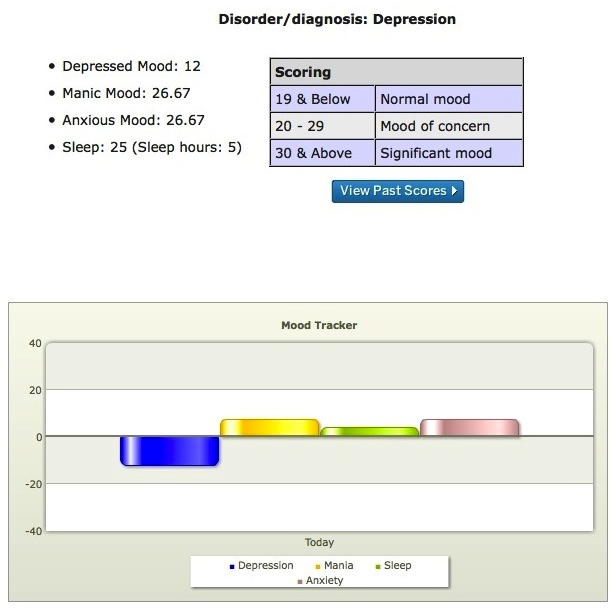
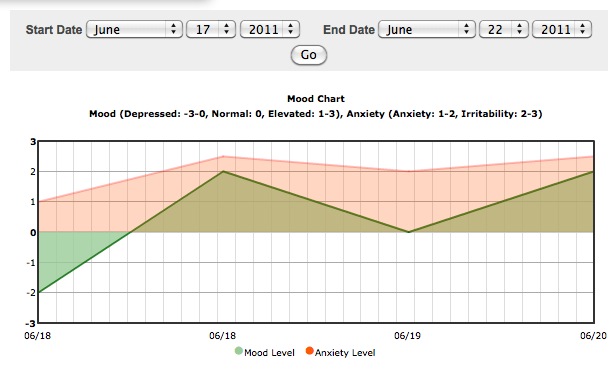




I just visited optimism online and found that they no longer charge for their online service.
Thanks, Al –
I’ve updated the post to indicate the change. It’s great news. Optimism is state of the art for this kind of software.
John